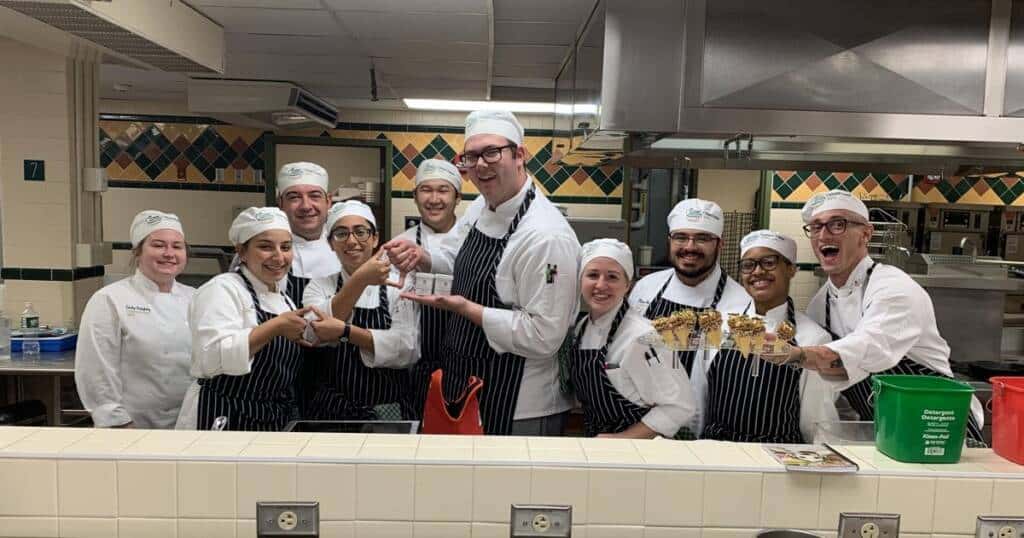
When I reached the Ingredient Functionality class in my culinary science bachelor’s program, I had no idea what I was about to learn. We briefly studied hydrocolloids in previous classes, but I still was clueless. I was feeling excitement and even a little fear, as I was walking into a class taught by our dean of culinary science, Ted Russin—who, by the way, happens to be an expert in hydrocolloids!
The Beginning
On the first day, I was sitting with a bagel and latte at 8:15 a.m., slowly biting on my bagel and laughing like a mad man, as I listened to our professor joke with us about how we are murderers for eating the seeds or as he called them “the babies of the trees.” After everyone’s initial stiffness loosened up, we went ahead with the regular syllabus.
The Class
For five weeks, we learned about the different hydrocolloids—from xanthan gum to gellan gum to carrageenan—and their uses. As a fan of bubble tea, I was excited to understand how the popping bubbles in bubble tea work. At first,
learning about these ingredients in theory seemed overwhelming, but as we got our hands dirty in the kitchen we slowly understood how amazing the products were. A running joke that went around class: when one of us couldn’t figure out what to do with a sauce, someone would say “Put some xanthan gum in it.”
Xanthan gum is definitely an “all-rounder”—it can go in anything! Throughout the class, we went through the different labs specifically highlighting xanthan gum, gellan gum, and pectin. Projects included:
- A drink that had suspended orbs in it.
- Deep-fried hollandaise, which when cut open oozes a beautiful yellow sauce.
- A stabilized coconut sorbet that was set on fire.

The Mystery Basket
On our last kitchen day, we had to do a “mystery basket” assignment. The chef presented us with ingredients from the storeroom, which I might add is a very smart way to get rid of the extra food there! He said, “Take what you want from here or from the gardens and make me a complete dish using certain hydrocolloids.”
Many of us were baffled, not knowing what to do. We had basic vegetables in the kitchen like onion, ginger, carrots, and some chilies and a great range of meats, from Tuscan sausages we made in class to different parts of the pork to smoked salmon. I grabbed a few slices of pork belly and a chunk of pork bottom, as well as some of the vegetables.
After gathering what we could, many of us ran to the community garden behind Roth Hall, carefully inspecting every type of crop, desperately trying to compose a plate together. I grabbed the candied and gold beets, fresh garlic, and a few ounces of lemon mint, which grew beautifully thanks to our Sustainability Committee and the staff that take care of the garden.
Once we washed the dirt off the vegetables, I stood in front of my bench staring back and forth at the vegetables, meat, and my book, wondering what to do. I had a good amount of time to compose a dish for chef, so I made my own trip to the storeroom and luckily found some whole wheat flour, which is an important part of North Indian cuisine as it makes different breads. That got my gears grinding. I could use it to create an Asian fusion dish!

Making the dish was the easy part—the catch was using gellan gum, xanthan gum, and meat glue in it. Here’s how I did it:
- I made a beet serrano chutney using gellan gum and a burned garlic mint sauce using xanthan gum.
- Then I took slices of pork belly and made rolls with it using cubed pork belly and meat glue.
- I followed that up by taking some of the pork bottom, minced it, and stuffed it in Indian bread, making parathas.
- To accompany all of this I made a black pepper stew containing some of the cubed pork bottom and the rolls.
The Result—A Better Chef!
The amount of creativity in culinary science is only limited by one’s imagination. My classmates have made magnificent dishes, both savory and sweet, that are just breathtaking. I truly believe this class has developed my skills and made my cooking techniques much better, because now I understand the functionality behind these ingredients much better and know how to use them more efficiently.
By Abhav Malhotra a student in the bachelor’s in culinary science degree program at the CIA’s New York campus.
